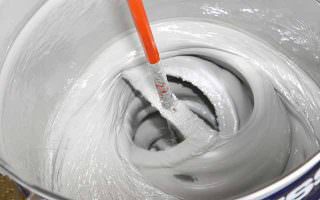Following a recent site visit to a local manufacturing company in North Hertfordshire, my colleague and I were invited to inspect their factory floor. Previously applied paints and resin coatings were failing drastically and showing serious signs of delimitation.
Recently Painted Walkway
Whilst inspecting the various floor coatings throughout the factory, we noticed that a marked out walkway had recently been painted in a bright blue paint. One thing that didn’t look quite right was the footprints that had been made by a person walking along the marked area. There was also a very suspect sheen to the coating, as if it was still wet!

On inspection, the walkway paint coating that had been applied over a week earlier was still extremely tacky. I made enquiries around the production facility to see if any of the staff knew anything about the application of the suspect floor paint. Finally, after many questions, a member of staff with a red face owned up to being the person who volunteered to do the painting. They explained to us what product they had used and showed us the tins.
Two Component Products
It turned out the paint used was a 2 pack product. However, the paint had been applied as if it was a single pack product by just opening the larger of the two tins and painting it directly onto the floor. The Activator (component B) was nowhere to be seen. All that had been applied to the floor was the Base (component A). This meant that the floor coating was never going to dry as the required procedure is to mix components A & B together using a paddle mixer.
Why It Is Important To Mix The Product Correctly
This creates a chemical reaction which ensures cross linking between both components. This reaction allows the paint to go off and harden. If the mixing is not carried out evenly throughout the tin, or for the correct amount of time, hot spots can occur. The paint will become extremely hot and the pot life will be dramatically reduced. This then shortens the useable time the applicator has to apply it. If the hardener is not mixed correctly i.e. with the use of a stick, rather than an electric paddle mixer, the result can also mean some areas where the paint has cured and gone hard and other areas where it remains uncured and never dries.
We were asked by the warehouse manager what could be done? Could they pour the hardener over the paint? The answer is no. The only solution is to scrape the wet paint off the floor, than have the floor blasted to remove any old coatings and create a profile for the new paint to adhere to. This makes the remedial work’s expensive, not only in time but also in cost.
Manufacturers Data Sheets
Manufacturers produce data sheets that explain the requirements for mixing, pot life, curing times, application temperatures and application method. These are readily available. It is highly recommended that before any painting is carried out – be it floors, walls, interior or exterior – that you refer to them.
The floor paint chosen by the local company had not been purchased from Promain but from another distributor who are not manufacture trained in 2 pack industrial paint coatings. They did not offer any technical advice or copies of the data sheets, when the paint was purchased.
This is a common problem, that we hear at Promain. So, we ask people – if in doubt please call for free advice and avoid wasting your time and money. For information and technical advice on all of our products give our Technical Team a call – they will be glad to help. Helping you to get your project right … first time!

